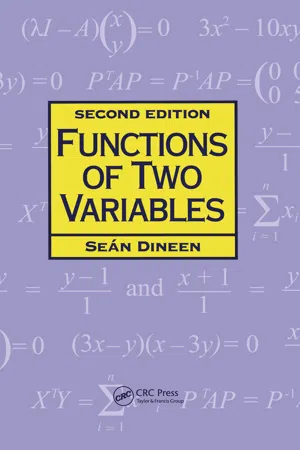
Functions of Two Variables
Sean Dineen
- 208 páginas
- English
- ePUB (apto para móviles)
- Disponible en iOS y Android
Functions of Two Variables
Sean Dineen
Información del libro
Multivariate calculus, as traditionally presented, can overwhelm students who approach it directly from a one-variable calculus background. There is another way-a highly engaging way that does not neglect readers' own intuition, experience, and excitement. One that presents the fundamentals of the subject in a two-variable context and was set forth in the popular first edition of Functions of Two Variables.The second edition goes even further toward a treatment that is at once gentle but rigorous, atypical yet logical, and ultimately an ideal introduction to a subject important to careers both within and outside of mathematics. The author's style remains informal and his approach problem-oriented. He takes care to motivate concepts prior to their introduction and to justify them afterwards, to explain the use and abuse of notation and the scope of the techniques developed.Functions of Two Variables, Second Edition includes a new section on tangent lines, more emphasis on the chain rule, a rearrangement of several chapters, refined examples, and more exercises. It maintains a balance between intuition, explanation, methodology, and justification, enhanced by diagrams, heuristic comments, examples, exercises, and proofs.
Preguntas frecuentes
Información
1
Functions from R2 to R
- (i) it may occur at a point inside [a, b], i.e., in (a, b) or
- (ii) it may occur at a boundary point, i.e., at either a or b.
